|
|
|
 |
|
|
|
|
|
|
|
Church Street
|
|
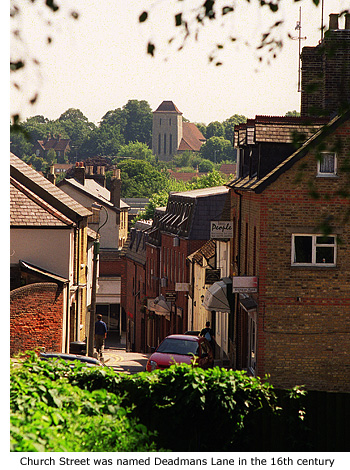 This narrow thoroughfare links South Street with High Street, just as it did in the Middle Ages when it was the town's southern-most boundary. But at that time the route had two separate names: this part being called Tenter, or Teynter, Hill and that part at the top of the hill where it turns right towards High Street, called Churche Lane [sic]. This narrow thoroughfare links South Street with High Street, just as it did in the Middle Ages when it was the town's southern-most boundary. But at that time the route had two separate names: this part being called Tenter, or Teynter, Hill and that part at the top of the hill where it turns right towards High Street, called Churche Lane [sic].
The name 'tenter' is derived from the Latin 'tentorium' meaning 'shelter made of stretched skins', and is defined as 'a framework with hooks used for stretching and drying cloth'. The primary function of a tenter, however, was to achieve the correct dimensions of cloth as laid down by law (first recorded in 1196, Assize of Measures). From the Middle Ages onwards, such frameworks were commonly used in the textile industry.
Tenters occupied large areas of ground, and in towns and cities with a history of textile making the name 'Tenter Ground' can still to be found. But unlike nearby Essex, neither Bishop's Stortford or East Hertfordshire is recorded as having a textile industry, although cloth making did take place here and use of tenter ground would seem the only logical reason why present-day Church Street was originally named Tenter, or Teynter Hill.
Further evidence of cloth making in Stortford comes from two sources: first, former local historian F.H. Maud, who refers to a *tenter barn at the corner of Church Street and Potter Street [where Boots now stands], used to prevent the cloths from getting wet; and secondly from Militia lists of the 18th century that show 25 local men working in the cloth trade. Women weren't included in these lists but there can be little doubt that many were involved in spinning.
*This tenter barn may have been a later substitute for a tenter ground, probably taken for development purposes.
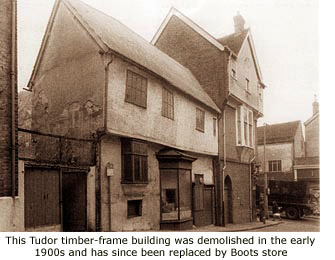 Church Street takes its name from the rather obvious fact that it leads to the church, but at the time of the plague in the 16th century it was given the chilling but equally honest name of Deadmans Lane. Church Street takes its name from the rather obvious fact that it leads to the church, but at the time of the plague in the 16th century it was given the chilling but equally honest name of Deadmans Lane.
That title superceded Tenter, or Teynter Hill, when the law required that corpses of plague victims should be carried to their burial place by a route other than the busy thoroughfare. In Bishop’s Stortford’s case the ‘busy’ thoroughfare would have been the market place, making this route the only alternative to St Michael’s churchyard – the entrance to which was at the top of the hill. On each of the three occassions plague visited the town, victims were buried in the southern-most part of the churchyard (disused since the mid 19th century).
In more recent times, Church Street was home to Bishop’s Stortford’s Technical Institute, a three-storey building dedicated to further education and the teaching of skilled trades. Built around 1891 it was also used for public lectures, Bible readings and as a temporary home to both Waterside school and St Joseph’s school (See Guide 5). Demolished in 1970, it has since been replaced by Nos 5-7.
|
|
Apart from the privately owned Nos 11-15, all of Church Street’s older properties have now been converted for commercial use, the tiny house adjoining Boots store being no exception. Until fairly recently this was an office for the local Methodist chuch, itself resident in Church Street from 1825–1866 when the local congregation used a converted seed warehouse as a chapel. Also here was the Woolpack public house, which was later named the Travellers Rest and then the Travellers Friend. The date of construction is unknown but it was demolished in 1892.
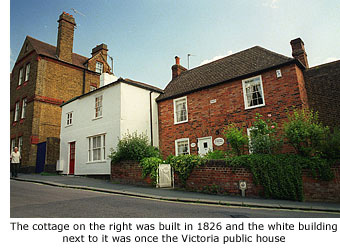 The delightful small cottage at the top of the hill bears the date 1828, and No 22 that adjoins it was once the Victoria public house. This was also the birthplace of Ernest Edward Smith – the man largely responsible for bringing the modern cinema to the town – born here on 5 March 1872 while his mother was staying with relatives who ran the pub. The delightful small cottage at the top of the hill bears the date 1828, and No 22 that adjoins it was once the Victoria public house. This was also the birthplace of Ernest Edward Smith – the man largely responsible for bringing the modern cinema to the town – born here on 5 March 1872 while his mother was staying with relatives who ran the pub.
Directly opposite stands the former Vicarage of St Michael’s, rarely viewed in its entirety due to the high wall that surrounds it and the large wooden entrance gates usually being closed. It was built in 1686 by the Rev Christopher Cooper.
Christopher Cooper's (1655?-1698) birthplace is unknown but it could well have been Buntingford in north Hertfordshire where, on the basis of the dedication of his Grammatica to Seth Ward, the bishop of Salisbury, it is thought that he was a charity boy of the local poorhouse.
He obviously caught the attention of the Buntingford-born bishop, for it was Ward who enabled Cooper to go up to Cambridge. Cooper matriculated and was admitted to Corpus Christi College in 1672. He received his BA degree in 1676 (it is from this date that his birth date has been calculated at 1655 as he would have been about 20 when he took his BA), and proceeded MA in 1680.
On 21 May 1676 he was ordained deacon in London. Cooper's first appearance in Bishop's Stortford was when he preached a sermon at St Michael's church on 11 March 1684. By the time his Grammatica was published in 1685, Cooper had already become headmaster of the Bishop's Stortford Grammar school, and on 11 March 1686 became vicar of St Michael's.
Cooper was responsible for two published grammars: the Grammatica linguae Anglicanae (1685) and The English Teacher (1687). The second, a translation of two parts of the first, has little grammar but a great deal on pronunciation: it is for this influential work that Cooper is hailed by some as the greatest of the 17th century phoneticians, on the basis of the completeness and accuracy of his systematic analysis of a southern dialect of English. Christopher Cooper devoted himself to the practical task of teaching English pronunciation, spelling and grammar: 'He that would write more exactly, must avoid barbarous pronunciation', he reaffirmed, considering that 'many words are not sounded after the best dialect'. He was incorporated at Oxford in 1694 and remained as vicar of the parish until his death in 1698.
The size of this property reflects the wealth of the Church in the 17th century. In fact, it is said that when Rev Francis Rhodes moved here with his family in 1849, his wife employed ten servants to help her run the house. But their employment was brief. The following year Rev Rhodes temporarily gave up the vicarage to accommodate pupils and a headmaster while the High School he had instigated was being built at the corner of Church Street and High Street (See Guide 3). Though still named The Vicarage this property was sold to private ownership in the early 1990s, and part of its ground sold for construction of another house around 2004.
*Several schoolmasters published spelling-books during the 17th century, which incorporated basic guides to correct forms of pronunciation. Simon Daines urged his pupils in Suffolk to make their writing and speaking conform and to 'follow the custome of the learned'. Thomas Hunt, a schoolmaster at Salisbury and later in London, produced another example in 1661, unusually in the form of a dialogue. And in 1674, Elisha Coles published 'Complete English Schoolmaster', based on the premiss that 'all words must so be spell'd, as they afterwards to be pronounc'd'.
*Additional information about Christopher Cooper taken from the Oxford Dictionary of National Biography
|
|
|
|
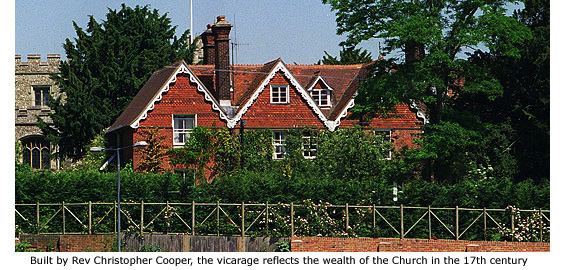 |
|
|
|
Old Police Station
|
|
As already described in Guide 7 (Local Government), between the 17th and early 19th century local authority was in the hands of the Parish Vestry, formed of four principle officials one of whom was a constable responsible for law and order. It was the practise of the Vestry to nominate 15 persons who were qualified and liable to serve as constables, and then for the local magistrates to approve two or four names from the list.
The job of constable was not particularly sought after because duties were often unpleasant and sometimes dangerous, but they were paid for what they did. In 1824, churchwardens made the following payments to constables:
Attending the public houses 13 Sundays at 2s. 6d. each from January 4th to March 28th, both included............£1. 12s. 6d.
Putting a stranger in the stocks for being riotsome in the streets...........1s. 6d.
Putting Cherry Hook in for being riotsome in the streets........1s. 6d.
Placing James Warwick in the stocks for being drunk on the Sunday, help, etc......1s. 6d.
Placing two men from Quendon, late at night, for ditto and disorderly conduct....2s. 0d.
Paid 2 pots of beer for assistance...........1s. 0d.
Backed up by Justices of the peace and assize judges, rural society relied heavily on this parochial ‘amateur’ constabulary.
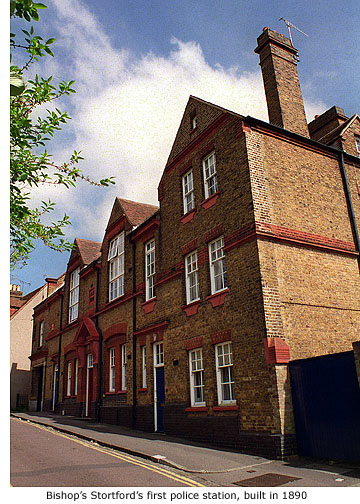 Law and order in cities was run on much the same principle but in 1829 the Home Secretary, Sir Robert Peel, created the first Metropolitan police force for London – a well-disciplined uniformed force controlled directly by Peel himself. Rural areas had nothing to compare. In fact, the Poor Law Amendment Act of 1834 actually stopped the practise of paying parish constables out of the poor rates, the result of which left many parishes without even a constable. Locally, however, the Bishop’s Stortford Association did organise a small constabulary in the town, as well as in Little Hadham and possibly Sawbridgeworth. Law and order in cities was run on much the same principle but in 1829 the Home Secretary, Sir Robert Peel, created the first Metropolitan police force for London – a well-disciplined uniformed force controlled directly by Peel himself. Rural areas had nothing to compare. In fact, the Poor Law Amendment Act of 1834 actually stopped the practise of paying parish constables out of the poor rates, the result of which left many parishes without even a constable. Locally, however, the Bishop’s Stortford Association did organise a small constabulary in the town, as well as in Little Hadham and possibly Sawbridgeworth.
It was the Municipal Corporation Act passed in 1835 that encouraged towns and cities to form their own police force, and in January 1836 the Hertford Borough Police was formed – Hertfordshire's very first police force. This was followed six months later by the establishment of St Albans Borough Police.
In 1839 a Royal Commission brought about the County Police Act, but it still wasn’t mandatory for a county to form a police force. Only half of England’s 56 counties adopted the idea and many made only a token gesture to comply. Urban areas were generally in favour of such a force but country people were against, believing that large rural areas would be unable to be policed and that they would end up subsidising urban dwellers.
Despite these fears the Hertfordshire Constabulary was formed on 12 April 1841 and responsibilty for policing the county's 120,000 population put in the hands of a Chief Constable, four Superintendents, six Inspectors and sixty constables. The estimated annual cost was in excess of £5,000.
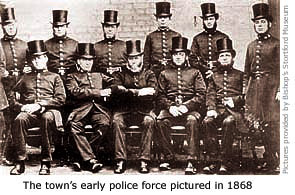 A year after the force's formation the following statistics were released: of 1,642 persons charged with offences, 1,180 were convicted; 50% of all stolen property was recovered; and in the whole of the Hatfield division only two sheep were stolen! A year after the force's formation the following statistics were released: of 1,642 persons charged with offences, 1,180 were convicted; 50% of all stolen property was recovered; and in the whole of the Hatfield division only two sheep were stolen!
In 1853 a government committee recommended the formation of a county police force should be made compulsory, and in 1856 the County and Borough Police Act was passed, making it obligatory for all county and town authorities to create a police force.
Hertfordshire's most successful Chief Constable, appointed in 1880, was Colonel Henry Daniell, a former soldier who had made his mark in India. He made it his task to reform and reorganise the constabulary and soon reduced the Hertfordshire force from eleven divisions to just five: Bishop's Stortford, Hemel Hempstead, Hitchin, St Albans and Ware. He also centralised the training of officers, introduced an exam for all new recruits, and in 1900, as a possible space-saver, ordered the destruction of all police records prior to 1890.
 The introduction of female officers to the constabulary was first suggested by Letchworth Parish Council in 1917, but not until 1928 were the first two women officers recruited. Both were promoted to Sergeant in 1939 and by 1944 Hertfordshire had thirteen women police officers. The introduction of female officers to the constabulary was first suggested by Letchworth Parish Council in 1917, but not until 1928 were the first two women officers recruited. Both were promoted to Sergeant in 1939 and by 1944 Hertfordshire had thirteen women police officers.
Between 1841 and 1962, thirty two police stations were built for the Hertfordshire Constabulary, among them, in 1890, Bishop's Stortford's Church Street police station at a cost of £3,950. This included a magistrates court.
The local force at that time comprised of a superintendent, one sergeant and five constables, though why it was such a small contingent compared to the town's twelve man police force photographed in 1868 is something of a mystery. But by the 1930s the force had increased significantly and in 1937 both they and the magistrates court moved to new headquarters in High Street – built on the former site of Middle Row (See Guide 3). Still to be seen in the former exercise yard at the rear of Church Street police station are carvings made in the brickwork by former prisoners.
The old Police station was later used by the Herts Probation and After-Care Service, as well as by the Herts County Territorial Army Volunteer Reserves and Cadet Committee. It was converted to offices and living accommodation in 1987.
A number of old houses from Bishop’s Stortfords past still stand in Church Street, they like the town itself, over-shadowed by St Michael’s church – a silent but prominent witness to six centuries of Bishop's Stortford's history. MORE PICTURES
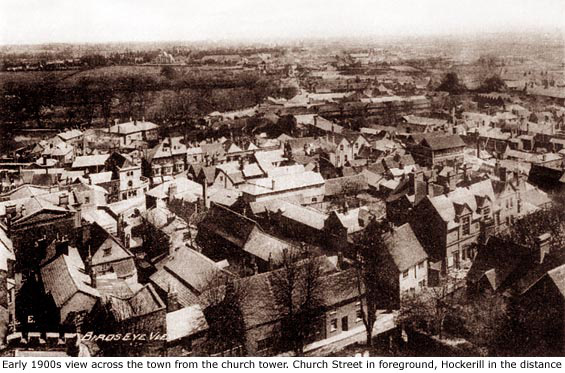
|
|
|
|
|
|
[ BACK TO TOP ] |
|
|
|
|
|
|
|
|
|




 This narrow thoroughfare links South Street with High Street, just as it did in the Middle Ages when it was the town's southern-most boundary. But at that time the route had two separate names: this part being called Tenter, or Teynter, Hill and that part at the top of the hill where it turns right towards High Street, called Churche Lane [sic].
This narrow thoroughfare links South Street with High Street, just as it did in the Middle Ages when it was the town's southern-most boundary. But at that time the route had two separate names: this part being called Tenter, or Teynter, Hill and that part at the top of the hill where it turns right towards High Street, called Churche Lane [sic]. Church Street takes its name from the rather obvious fact that it leads to the church, but at the time of the plague in the 16th century it was given the chilling but equally honest name of Deadmans Lane.
Church Street takes its name from the rather obvious fact that it leads to the church, but at the time of the plague in the 16th century it was given the chilling but equally honest name of Deadmans Lane. Law and order in cities was run on much the same principle but in 1829 the Home Secretary, Sir Robert Peel, created the first Metropolitan police force for London – a well-disciplined uniformed force controlled directly by Peel himself. Rural areas had nothing to compare. In fact, the Poor Law Amendment Act of 1834 actually stopped the practise of paying parish constables out of the poor rates, the result of which left many parishes without even a constable. Locally, however, the Bishop’s Stortford Association did organise a small constabulary in the town, as well as in Little Hadham and possibly Sawbridgeworth.
Law and order in cities was run on much the same principle but in 1829 the Home Secretary, Sir Robert Peel, created the first Metropolitan police force for London – a well-disciplined uniformed force controlled directly by Peel himself. Rural areas had nothing to compare. In fact, the Poor Law Amendment Act of 1834 actually stopped the practise of paying parish constables out of the poor rates, the result of which left many parishes without even a constable. Locally, however, the Bishop’s Stortford Association did organise a small constabulary in the town, as well as in Little Hadham and possibly Sawbridgeworth. A year after the force's formation the following statistics were released: of 1,642 persons charged with offences, 1,180 were convicted; 50% of all stolen property was recovered; and in the whole of the Hatfield division only two sheep were stolen!
A year after the force's formation the following statistics were released: of 1,642 persons charged with offences, 1,180 were convicted; 50% of all stolen property was recovered; and in the whole of the Hatfield division only two sheep were stolen! The introduction of female officers to the constabulary was first suggested by Letchworth Parish Council in 1917, but not until 1928 were the first two women officers recruited. Both were promoted to Sergeant in 1939 and by 1944 Hertfordshire had thirteen women police officers.
The introduction of female officers to the constabulary was first suggested by Letchworth Parish Council in 1917, but not until 1928 were the first two women officers recruited. Both were promoted to Sergeant in 1939 and by 1944 Hertfordshire had thirteen women police officers.